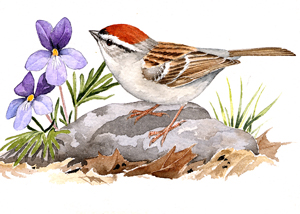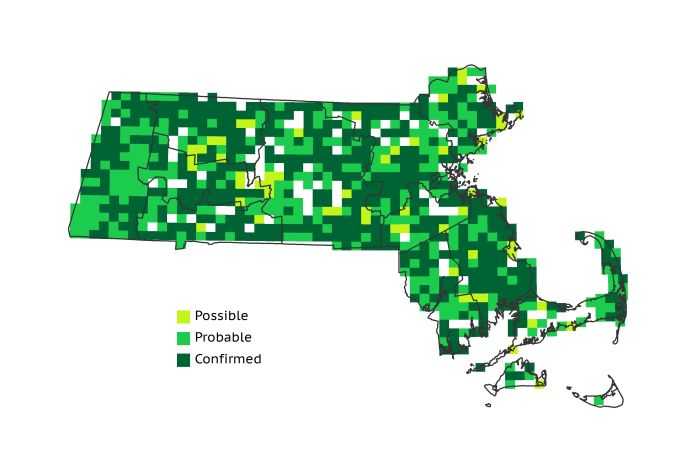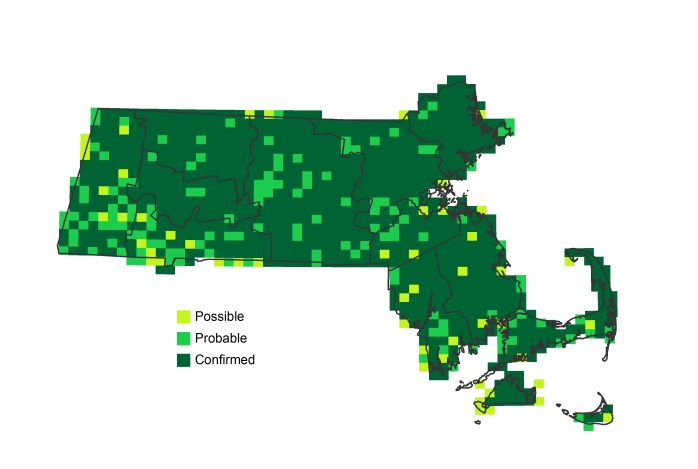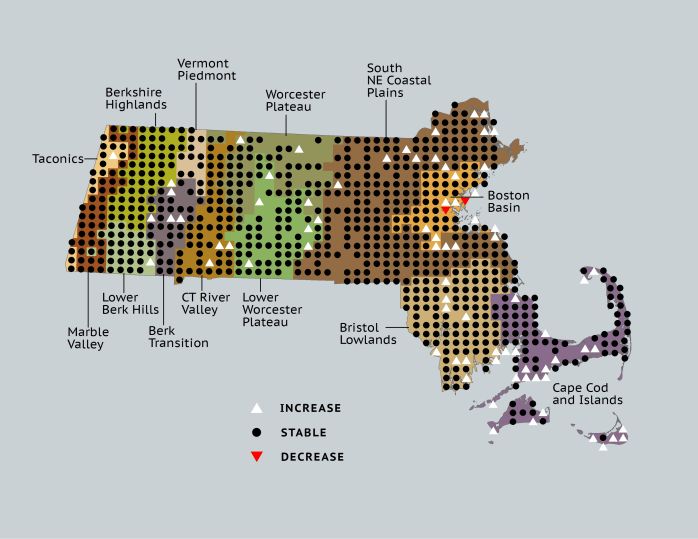Breeding Bird Atlases (BBA)
Find a Bird
Chipping Sparrow
Spizella passerina

Nearly ubiquitous and likely increasing
“…the little chippy would trill his wiry tremulo, like the locust’s hot weather warning, while his mate brooded over five tiny greenish-blue eggs in the boxwood tree.” – Neltje Blanchan, Birds Every Child Should Know
Tiny and energetic, the Chipping Sparrow is a very common bird throughout the Commonwealth. The species’ chestnut cap and exceptional tameness makes this tiny sparrow easy to identify, as do the sharp chip calls that give the bird its name. Although some of our sparrow species are struggling to hold on as their populations dwindle in the face of large-scale changes in the Massachusetts landscape, the Chipping Sparrow is prospering since its fondness for forest clearings and suburban landscapes is serving the species well.
Historic Status
From the earliest accounts of the birds of Massachusetts, the Chipping Sparrow has been known as one of the most abundant and familiar species in the state. “It is found alike in the city and the village, in the field and the garden, in the forest and at the house-door,” wrote William Peabody (Peabody 1839). Never a denizen of the forest, it thrived when Massachusetts was mostly farmland, and likely increased after the state began the post-agricultural era reforestation process. It became known as “the little brown-capped pensioner of the dooryard and lawn, that comes about farmhouse doors to glean crumbs shaken from the tablecloth by thrifty housewives” (Forbush 1929). The Chipping Sparrow went on to gradually become the one of the most broadly distributed breeding birds in Massachusetts.
Atlas 1 Distribution
Chipping Sparrows flocked to clearings, both natural and cut, all across the Commonwealth during Atlas 1, and occurred in 84% of the blocks surveyed. They were found in over 94% of the blocks west of the Connecticut River Valley, and absent only from a handful of blocks in the southern edge of that region. The conspicuous thinning in their distribution on the Worcester Plateau is likely an artifact of coverage as much as a symptom of the species’ aversion to deep, closed areas of forest. Through much of the eastern parts of the state, Chipping Sparrows were widespread but less so than in the west. Cape Cod and the Islands supported a lower density of breeding Chipping Sparrows, with very little activity on Mid-Cape Cod and only 1 occupied block on Nantucket.
Atlas 2 Distribution and Change
Despite this near ubiquity in Atlas 1, Chipping Sparrows still managed to find room to grow and spread their chippy joy during Atlas 2, and they increased to 95% block occupancy statewide. It was the eastern portion of the state that afforded them the most room for growth. The Coastal Plains, Bristol/Narragansett Lowlands, and Cape Cod and the Islands all sported a growing footprint for Chipping Sparrows in Atlas 2. The Chipping Sparrow came in twelfth in the overall distribution competition.
Atlas 1 Map

Atlas 2 Map

Atlas Change Map

Ecoregion Data
Atlas 1 | Atlas 2 | Change | ||||||
Ecoregion | # Blocks | % Blocks | % of Range | # Blocks | % Blocks | % of Range | Change in # Blocks | Change in % Blocks |
Taconic Mountains | 15 | 93.8 | 1.8 | 21 | 84.0 | 2.1 | 1 | 6.7 |
Marble Valleys/Housatonic Valley | 39 | 100.0 | 4.8 | 39 | 100.0 | 4.0 | 0 | 0.0 |
Berkshire Highlands | 53 | 96.4 | 6.5 | 55 | 100.0 | 5.6 | 1 | 1.9 |
Lower Berkshire Hills | 27 | 96.4 | 3.3 | 30 | 96.8 | 3.0 | 1 | 3.7 |
Vermont Piedmont | 15 | 88.2 | 1.8 | 17 | 100.0 | 1.7 | 0 | 0.0 |
Berkshire Transition | 33 | 86.8 | 4.1 | 40 | 100.0 | 4.1 | 4 | 12.9 |
Connecticut River Valley | 51 | 91.1 | 6.3 | 63 | 96.9 | 6.4 | 3 | 6.3 |
Worcester Plateau | 68 | 87.2 | 8.4 | 88 | 100.0 | 8.9 | 4 | 8.3 |
Lower Worcester Plateau | 60 | 81.1 | 7.4 | 80 | 100.0 | 8.1 | 5 | 9.3 |
S. New England Coastal Plains and Hills | 239 | 88.5 | 29.5 | 276 | 97.5 | 28.0 | 16 | 7.1 |
Boston Basin | 42 | 75.0 | 5.2 | 49 | 87.5 | 5.0 | 6 | 10.9 |
Bristol and Narragansett Lowlands | 92 | 86.8 | 11.3 | 112 | 98.2 | 11.4 | 11 | 10.9 |
Cape Cod and Islands | 77 | 56.6 | 9.5 | 114 | 79.2 | 11.6 | 23 | 19.2 |
Statewide Total | 811 | 83.7 | 100.0 | 984 | 94.9 | 100.0 | 75 | 9.0 |
Notes
The Chipping Sparrow’s Breeding Bird Survey (BBS) trend in Massachusetts is significantly increasing, but, confusingly, its BBS trend in the Eastern US overall is significantly declining.



